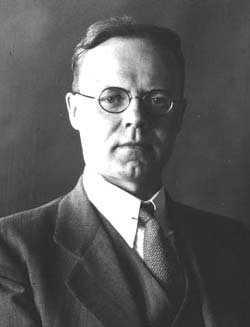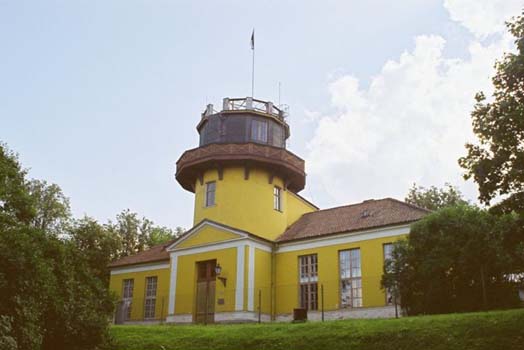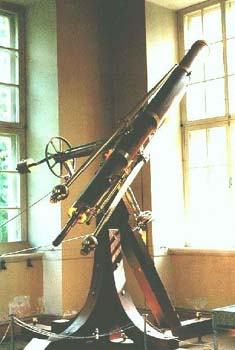 |
The
Struve Family |
 |
The
Struve Family |
 | A
Family Business |
 Otto Struve - great grandson of Otto Wilhelm and Peter's great great grandfather. | The observatory staff was very badly affected by the Great Purge and many Pulkovo astronomers, including the director Boris Gerasimovich, were arrested and executed in the late 1930s. During the siege of Leningrad (1941-1944), the Observatory became the target of fierce German air raids and artillery bombardment. All of the buildings were completely destroyed. Under dramatic conditions the main instruments were saved and stored safely in Leningrad, including the world's biggest telescope, as well as a significant part of the unique library with scripts and important works from the 15th to 19th Century. On February 5, 1997, nearly 1,500 of the 3,852 books were destroyed by malicious arson and the rest of the library items were damaged by flames, smoke or water damage. Even before the end of the war, the Soviet government made a decision to restore the Observatory. In 1946, they began the construction after having cleared the territory. In May 1954, the Observatory was re-opened, which had not only been restored but considerably expanded in terms of instruments, employees and research subjects. They created new departments, such as the Department of Radio Astronomy and Department of Instrument Making (with its own optical and mechanical workshop).The surviving old instruments were repaired, modernized and put into service once again. They also installed new instruments, such as the 65-cm refractor, horizontal meridian device, a photographic polar telescope, a big zenith telescope, stellar interferometer, 2 solar telescopes, coronagraph, a big radio telescope and all kinds of labware. The Simeiz station became a part of the new Crimean Astrophysical |
| constants,
such as precessions, nutations, aberrations and refractions, and also discovering
and measuring double stars. Observatory's activities have also been connected
to the geographical study of the territory of Russia and development of navigation.
The star catalogues, containing the most precise positions of 374, and then 558
stars, were made for the years 1845, 1865, 1885, 1905 and 1930. By the 50th anniversary of the Observatory, they had built an astrophysical laboratory with a mechanical workshop and installed the world’s largest 76-cm refractor. Astrophysical research really gained momentum with the appointment of Feodor Bredikhin as a director of the Observatory in 1890 and transfer of Aristarkh Belopolsky from the Moscow Observatory, an expert in stellar spectroscopy and solar research. In 1923, they installed a big Littrow spectrograph, and in 1940 - a horizontal solar telescope, manufactured at a Leningrad factory. After having received an astrograph in 1894, the observatory began its work on astrophotography. In 1927, the Observatory received a zone astrograph and with its help the Russian astronomers catalogued the stars of the near-polar areas of the sky. Regular observation of movements of celestial poles began with the construction of the zenith telescope in 1904. In 1920, the Observatory started transmitting the exact time by radio signals. The observatory participated in the basic geodesic work, namely in measuring degrees of the arc of the meridian from the Danube to the Arctic Ocean (until 1851), and in triangulation of Spitsbergen in 1899-1901. Military geodesists and hydrographers used to work at the Observatory as interns. The Pulkovo Meridian, which passes through the center of the main building of the Observatory and is located at 30°19,6‘ east of Greenwich, was the point of departure for all former geographical maps of Russia. In order to observe the southern stars that could not be seen on the observatory’s latitude, the scientists organized 2 affiliates. One of them was an astrophysical station in the Crimean town of Simeiz (Simeiz Observatory), which had been organized on the basis of a private observatory presented to the Pulkovo Observatory by an astronomy lover N.S.Maltsev in 1908. The other affiliate of the Pulkovo Observatory was an astrometric station in Nikolaev - a former observatory of the Department of the Navy (today’s Nikolaev Astronomical Observatory). |
Observatory of the Soviet Academy of Sciences in 1945. They also built the Kislovodsk Mountain Astronomical Station and a laboratory in Blagoveshchensk. The Observatory organized many expeditions for determining differences of longitudes, observing passages of Venus and solar eclipses, studying astroclimate. In 1962, the Observatory sent an expedition to Chile to observe stars in the southern skies. |
 The Old Observatory at Tartu now Dorpat Estonia |  The Great Dorpat Refractor |
| This
is the great 9" Franhaufer Refractor built by Joseph Franhaufer for Peter's
sixth great grandfather. It was one of the world's very first apochromatic telescopes.
George Frederick had a second identical one built for his Observatory in Pulkovoa
St Petersburg. Tartu Observatory was founded at the University of Tartu after it was reopened in 1802. The observatory building was completed in 1810 on the Toome hill in Tartu. The instruments were installed in 1814 by Friedrich Georg Wilhelm von Struve who subsequently started observations. In 1824, a 9" Fraunhofer refractor arrived, largest achromatic telescope in the world at the time. When Struve began assembling the Struve Geodetic Arc in 1816, the observatory became it's first point.In 1946 Tartu Observatory was separated from the University of Tartu and subjected to the Estonian Academy of Sciences. Search for the new observational base started in 1950. In 1957, a patch of land on Tõravere hill was assigned for the purpose and in 1958 construction began. By 1963, the new observatory building was completed, part of the astronomers from the old Tartu Observatory moved in and the 50 cm reflector telescope got first light. In 1964, an international conference was held and Tartu Observatory was given the name of F.G.W. Struve. In 1974 the 1.5 metre telescope become operational. The name of the observatory was reverted back to Tartu observatory in 1995. In 1998, a 0.6 metre reflector was installed, the last major instrument update for today. The old Tartu Observatory building now mainly serves as a museum and is a part of a public science education centre. Several notable scientists have been associated with the Tartu Observatory: Friedrich Georg Wilhelm von Struve, Johann Heinrich von Mädler, Thomas Clausen, Ernst Julius Öpik, Jaan Einasto.Tartu observatory has two main telescopes. The 1.5 metre Cassegrain reflector, which is the largest optical telescope in Northern Europe, is used for spectroscopic observations. The second telescope is a 0.6 metre reflector for photometric observations. There is also a pitch for a collection of meteorological instruments on the observatory grounds. Peter's website can be found at: http://peter-struve.wetpaint.com/page/A+family+Business (Copy & paste into your browser) Additional information courtesy of Wikipedia |